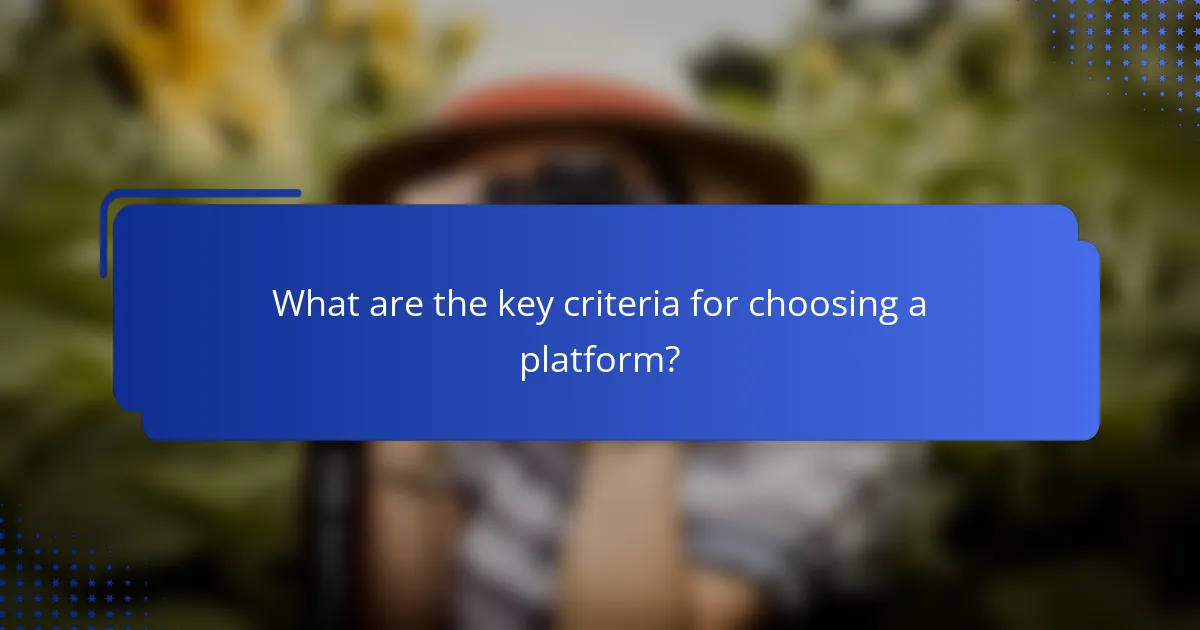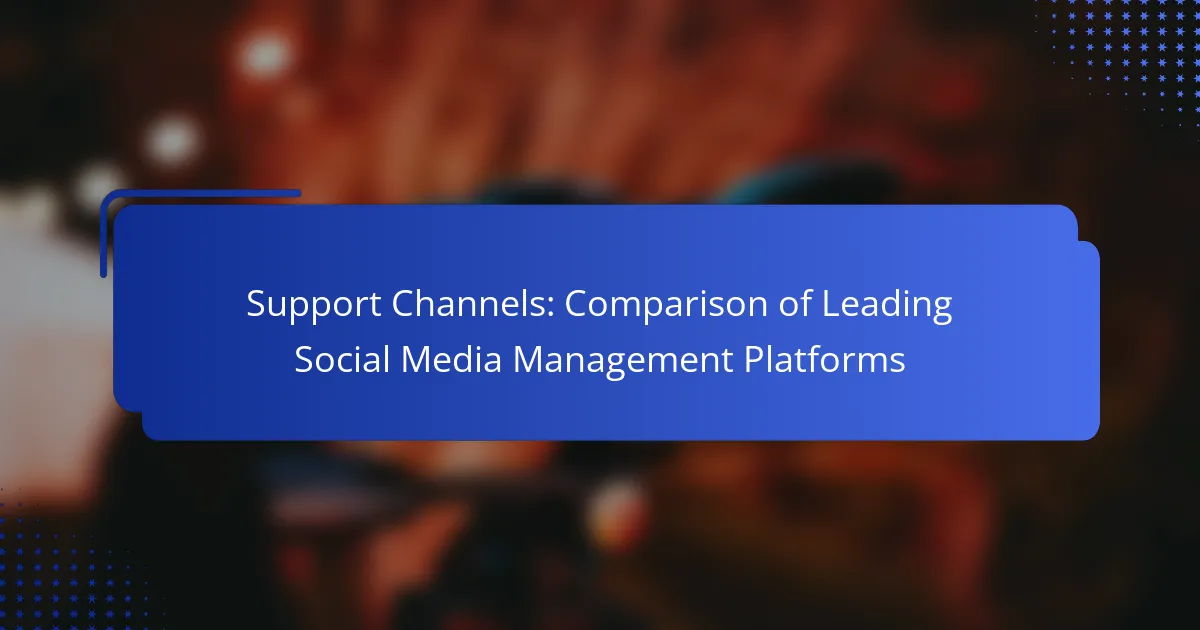In 2023, businesses seeking to enhance their online presence can choose from several leading social media management platforms, including Hootsuite, Buffer, Sprout Social, Later, and SocialBee. These platforms offer a range of features such as content scheduling, analytics, and collaboration tools, making it essential to compare them based on specific business needs and budget constraints.

Which social media management platforms are leading in 2023?
In 2023, the leading social media management platforms include Hootsuite, Buffer, Sprout Social, Later, and SocialBee. These tools are recognized for their robust features, user-friendly interfaces, and ability to streamline social media marketing efforts across various channels.
Hootsuite
Hootsuite is a comprehensive social media management platform that allows users to schedule posts, track performance, and engage with audiences across multiple networks. It supports major platforms like Facebook, Twitter, Instagram, and LinkedIn, making it versatile for businesses of all sizes.
Consider Hootsuite if you need advanced analytics and team collaboration features. Its tiered pricing model offers options for small businesses to large enterprises, with costs typically ranging from $19 to $599 per month depending on the plan.
Buffer
Buffer is known for its simplicity and effectiveness in scheduling posts and analyzing social media performance. It offers a clean interface that makes it easy to manage multiple accounts and track engagement metrics.
This platform is ideal for small to medium-sized businesses looking for an affordable solution, with pricing starting around $15 per month. Buffer’s browser extension also allows for quick sharing of content directly from the web.
Sprout Social
Sprout Social provides a robust set of tools for social media management, including scheduling, monitoring, and detailed reporting. Its user-friendly dashboard is designed to enhance team collaboration and streamline workflows.
With features like social listening and engagement tools, Sprout Social is suitable for businesses that prioritize customer interaction. Pricing starts at approximately $249 per month, reflecting its comprehensive capabilities.
Later
Later specializes in visual content planning, particularly for Instagram, but also supports Facebook, Twitter, and Pinterest. Its drag-and-drop calendar makes it easy to schedule posts visually, which is beneficial for brands focusing on aesthetics.
Later is a great choice for businesses that rely heavily on visual marketing. Plans start at around $12.50 per month, making it accessible for small businesses and influencers.
SocialBee
SocialBee offers a unique approach to content categorization, allowing users to organize posts into different categories for better scheduling and engagement. This feature helps maintain a balanced content mix across social platforms.
Ideal for small businesses and entrepreneurs, SocialBee’s pricing starts at about $19 per month. Its focus on evergreen content and recycling posts can save time and enhance engagement over the long term.

How do these platforms compare in features?
Leading social media management platforms vary significantly in their features, impacting how businesses manage their online presence. Key areas of comparison include content scheduling, analytics and reporting, and collaboration capabilities.
Content scheduling capabilities
Content scheduling is a critical feature that allows users to plan and automate posts across multiple social media channels. Most platforms offer a calendar view for easy planning, with options to set specific dates and times for posts to go live.
Some platforms, like Hootsuite and Buffer, provide advanced scheduling features such as bulk upload options and recurring posts, which can save time for users managing large volumes of content. Consider your posting frequency and the need for flexibility when choosing a platform.
Analytics and reporting tools
Analytics and reporting tools are essential for measuring the effectiveness of social media strategies. These features typically include metrics on engagement, reach, and audience demographics, helping businesses understand their performance.
Platforms like Sprout Social and HubSpot offer in-depth reporting capabilities, allowing users to generate custom reports and track performance over time. When selecting a platform, prioritize those that provide actionable insights tailored to your specific goals.
Collaboration features
Collaboration features facilitate teamwork within social media management, enabling multiple users to contribute and manage accounts effectively. Look for platforms that support user roles and permissions, allowing for streamlined workflows and accountability.
Tools such as Monday.com and Asana integrate well with social media platforms, enhancing project management capabilities. Ensure the platform you choose supports the level of collaboration your team requires, whether it’s simple task assignments or comprehensive project tracking.

What are the pricing structures of top platforms?
The pricing structures of leading social media management platforms vary significantly based on features, user limits, and service levels. Understanding these differences can help businesses choose the right platform that fits their budget and needs.
Hootsuite pricing tiers
Hootsuite offers several pricing tiers, including a free plan with limited features and paid plans that range from approximately $19 to $599 per month. The paid plans provide additional functionalities such as advanced analytics, team collaboration tools, and increased social profile connections.
When selecting a Hootsuite plan, consider the size of your team and the number of social media accounts you manage. The Professional plan is suitable for small businesses, while larger organizations may benefit from the Business or Enterprise tiers, which offer more comprehensive features and support.
Buffer pricing plans
Buffer’s pricing plans start at around $15 per month for the Essentials package, which includes basic scheduling and analytics tools. Higher tiers, such as the Team and Agency plans, can cost up to $99 per month or more, depending on the features and number of users.
Buffer’s straightforward pricing structure makes it easy to understand what you’re paying for. Businesses should assess their social media strategy and the number of profiles they need to manage when choosing a plan, as the higher tiers provide more robust capabilities for collaboration and reporting.
Sprout Social subscription costs
Sprout Social’s subscription costs begin at approximately $249 per month for the Standard plan, which includes essential features for social media management. The Professional and Advanced plans can reach up to $499 and $899 per month, respectively, offering enhanced analytics, reporting, and additional user seats.
For businesses that require extensive social media management tools, Sprout Social’s higher-tier plans are worth considering. Evaluate your specific needs, such as the level of customer engagement and reporting required, to determine which subscription level aligns with your goals.

What integrations do these platforms offer?
Leading social media management platforms provide a variety of integrations that enhance functionality and streamline workflows. These integrations often include connections to popular social networks, analytics tools, and customer relationship management (CRM) systems, allowing users to manage their online presence more effectively.
Hootsuite integrations
Hootsuite offers a wide range of integrations with over 150 apps, including major social networks like Facebook, Twitter, Instagram, and LinkedIn. It also connects with tools such as Google Drive, Dropbox, and Salesforce, enabling users to share content and analyze performance seamlessly.
When using Hootsuite, consider the specific integrations that align with your marketing goals. For instance, integrating with CRM systems can help track customer interactions and improve engagement strategies.
Buffer integrations
Buffer supports integrations with various platforms, including Facebook, Twitter, LinkedIn, and Pinterest. Additionally, it connects with tools like Zapier, which allows users to automate workflows between Buffer and other applications.
To maximize Buffer’s capabilities, focus on integrating it with tools that enhance your content scheduling and analytics. For example, using Buffer alongside Google Analytics can provide deeper insights into the performance of your social media campaigns.
Sprout Social integrations
Sprout Social features integrations with popular social networks such as Facebook, Twitter, Instagram, and LinkedIn, as well as tools like Google Analytics and HubSpot. This allows for comprehensive reporting and customer engagement tracking.
When leveraging Sprout Social, prioritize integrations that support your specific needs, such as customer support or lead generation. For instance, connecting with a CRM can streamline communication and improve response times for customer inquiries.

How do user experiences differ across platforms?
User experiences across social media management platforms vary significantly based on usability, features, and customer support. Hootsuite, Buffer, and Sprout Social each offer unique strengths and weaknesses that cater to different user needs and preferences.
User reviews for Hootsuite
User reviews for Hootsuite often highlight its comprehensive feature set, which includes scheduling, analytics, and team collaboration tools. Many users appreciate the ability to manage multiple social accounts from a single dashboard, making it a popular choice for larger teams.
However, some users report that the interface can be overwhelming for beginners, and the pricing may be a concern for smaller businesses. Overall, Hootsuite is seen as a powerful tool for those who need extensive functionality.
User reviews for Buffer
On the downside, some users feel that Buffer lacks advanced features compared to competitors like Hootsuite. While it excels in ease of use, those needing more robust analytics may need to look elsewhere.
User reviews for Sprout Social
Sprout Social is frequently praised for its excellent customer support and in-depth analytics capabilities. Users appreciate the detailed reporting features that help them understand audience engagement and optimize their social media strategies.
However, the cost of Sprout Social can be a barrier for smaller organizations, as it tends to be on the pricier side. Overall, it is favored by businesses looking for a comprehensive solution with strong analytical tools.

What are the key criteria for choosing a platform?
When selecting a social media management platform, consider factors such as usability, features, integration capabilities, and customer support. These criteria will help ensure the platform meets your specific needs and enhances your social media strategy.
Budget considerations
Budget is a critical factor when choosing a social media management platform, as costs can vary significantly. Platforms may charge monthly or annual fees, often ranging from low tens to several hundreds of USD, depending on features and user limits.
Evaluate what features are essential for your business. Some platforms offer tiered pricing models, allowing you to choose a plan that fits your budget while still providing necessary tools. Be cautious of hidden costs, such as additional fees for extra users or advanced functionalities.
Consider the return on investment (ROI) of the platform. A higher upfront cost may be justified if the platform significantly improves your social media engagement and analytics. Always compare multiple options to find the best value for your specific requirements.
